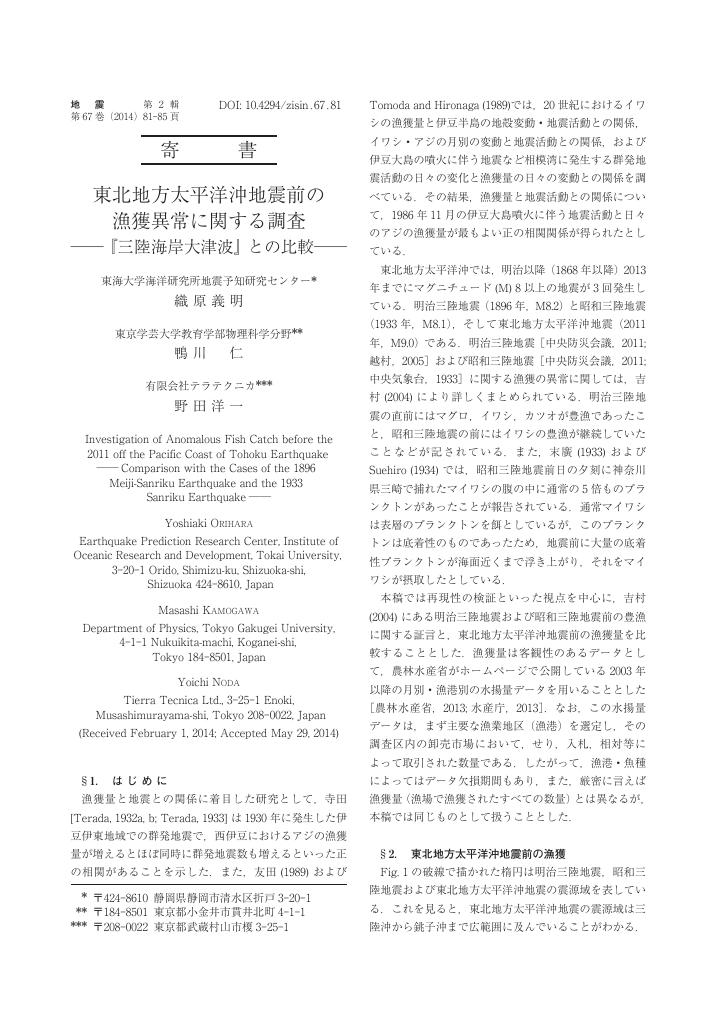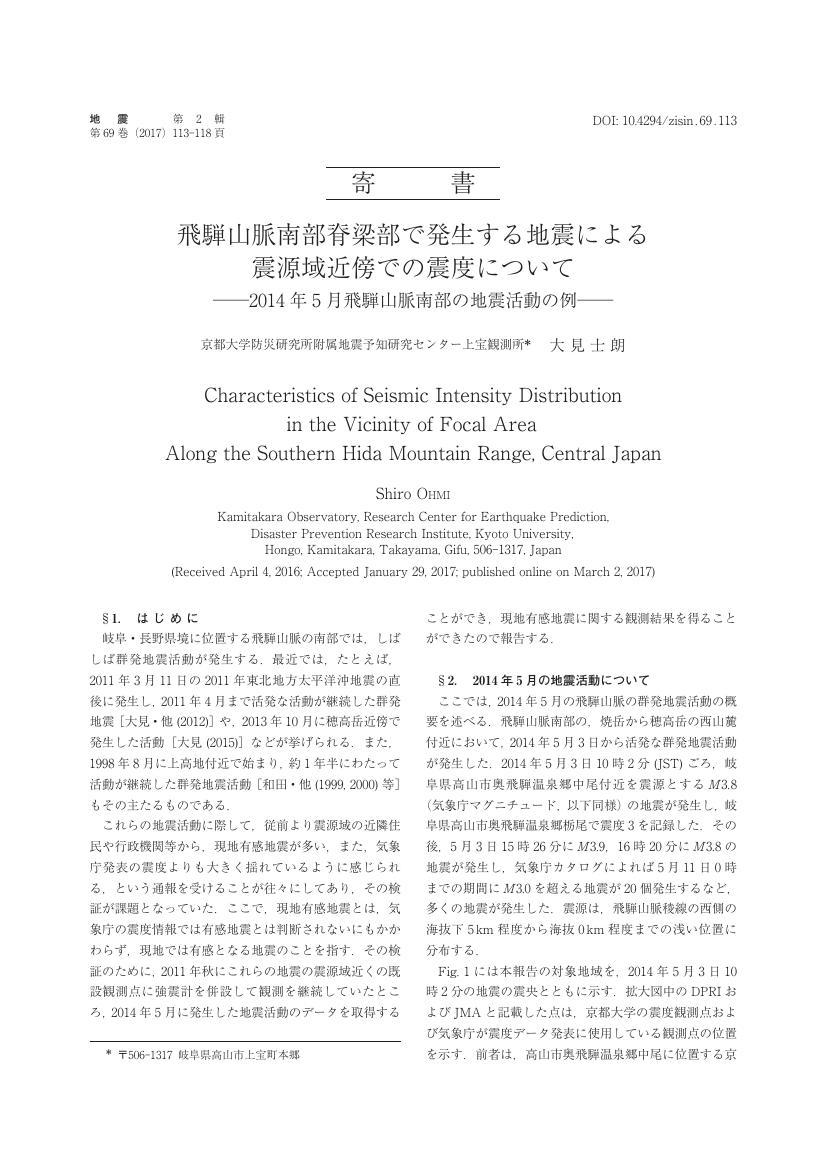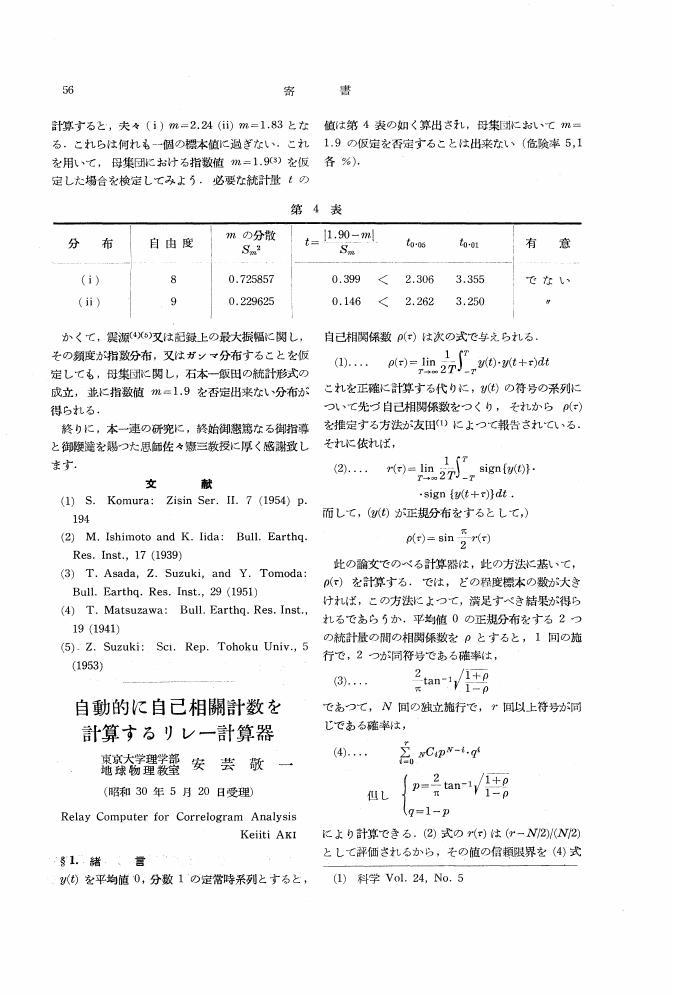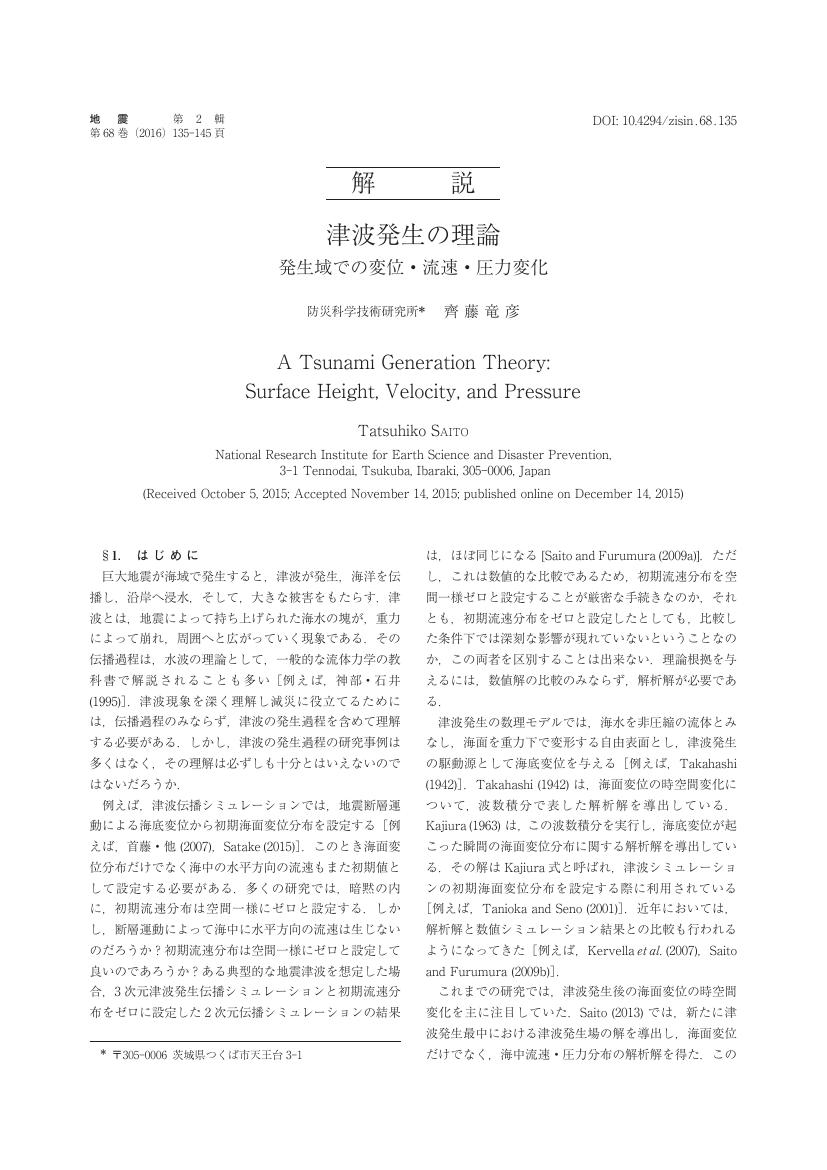7 0 0 0 OA 火山から離れた地域で発生している深部低周波微動・地震
- 著者
- 鎌谷 紀子 勝間田 明男
- 出版者
- 公益社団法人 日本地震学会
- 雑誌
- 地震 第2輯 (ISSN:00371114)
- 巻号頁・発行日
- vol.57, no.1, pp.11-28, 2004-08-25 (Released:2010-03-11)
- 参考文献数
- 30
- 被引用文献数
- 5
In recent years, improved seismic networks in Japan have detected low-frequency events near the Mohorovicic discontinuity, but away from volcanoes. These can be classified as two types: low-frequency earthquakes (LFE) and low-frequency tremors (LFT). Source regions for LFE are distributed in isolated locations throughout Japan, while those for LFT are distributed within a belt in western Japan. Although LFE immediately below volcanoes have been previously recognized, LFE away from volcanoes represent new observations. These LFE are found specifically both in the back-arc of the volcanic front in northeastern Japan, and to the north of the LFT belt in western Japan. LFE and LFT have long durations, suggesting the involvement of fluids in their generation. This study considers the source processes that trigger LFE and LFT, using the results of high pressure and temperature experiments on water-saturated oceanic basalt and peridotite as a model. Such materials are representative of those in and around the descending slab. In the case of LFT in western Japan, the model provides, as a possible trigger, the water released by the dehydration of chlorite and forming clinopyroxene in the basalt of the descending Philippine Sea Plate. On the other hand, in the case of LFE throughout Japan, not only water from the slab but also magma generated in the slab and mantle wedge and high temperature fluid derived from the magma are possible triggers. Because LFE have clear P-wave onsets, some sort of fracture is likely to be involved in the generation of LFE. LFE and LFT are expected to be indicators useful in earthquake prediction, but the relationships between large earthquakes or earthquake swarms and the occurrence of LFE and LFT are yet to be determined.
7 0 0 0 OA 慶長九年の東海南海兩道の地震津浪に就いて
- 著者
- 今村 明恒
- 出版者
- 公益社団法人 日本地震学会
- 雑誌
- 地震 第1輯 (ISSN:00371114)
- 巻号頁・発行日
- vol.15, no.6, pp.150-155, 1943-06-18 (Released:2010-11-17)
7 0 0 0 OA プレート成長に関する氷板とリソスフェアの類似性
- 著者
- 浜口 博之 後藤 和彦
- 出版者
- 公益社団法人 日本地震学会
- 雑誌
- 地震 第2輯 (ISSN:00371114)
- 巻号頁・発行日
- vol.34, no.1, pp.145-147, 1981-03-25 (Released:2010-03-11)
- 参考文献数
- 10
- 被引用文献数
- 1
7 0 0 0 OA 1918年大町地震の震源断層モデル
- 著者
- 鷺谷 威
- 出版者
- 公益社団法人 日本地震学会
- 雑誌
- 地震 第2輯 (ISSN:00371114)
- 巻号頁・発行日
- vol.56, no.2, pp.199-211, 2003-09-16 (Released:2010-03-11)
- 参考文献数
- 22
- 被引用文献数
- 1
The 1918 Omachi Earthquake occurred near Omachi city, along the northern Itoigawa-Shizuoka Tectonic Line Fault Zone. Leveling data associated with the earthquake were re-examined and corrected for artificial alteration. Corrected leveling data revealed about 200mm of uplift in the central Omachi and a slight subsidence in the southern part. However, the leveling data are not enough to resolve a fault model of the Omachi earthquake by themselves. Therefore a new fault model is developed based on the leveling, triangulation, and structural data. Estimated fault plane is 4.4km×10.0km wide, shallowly inclined to ENE at the base of the Matsumoto Basin. Estimated fault slip amounts to 1.2m and the seismic moment is estimated to be 1.8×1018Nm (Mw=6.1). The fault model is consistent with the observed surface rupture and horizontal crustal strain, which have been hardly explained by previous models. The 1918 Omachi earthquake is considered to have released WNW-ESE compressional stress by rupturing a shallow part of the crust. Although the source fault is discriminated from the East Matsumoto Basin Fault, these faults are interpreted to be the members of the same fault system. An integrated understanding of the whole fault system as well as inelastic deformation in the surrounding area is necessary to refine estimates on earthquake probabilities and strong ground motions.
6 0 0 0 OA 東北地方太平洋沖地震前の漁獲異常に関する調査——『三陸海岸大津波』との比較——
- 著者
- 織原 義明 鴨川 仁 野田 洋一
- 出版者
- 公益社団法人 日本地震学会
- 雑誌
- 地震 第2輯 (ISSN:00371114)
- 巻号頁・発行日
- vol.67, no.2, pp.81-85, 2014-09-30 (Released:2014-11-25)
- 参考文献数
- 14
- 被引用文献数
- 2 2
6 0 0 0 OA 日本の大地震は月齢と関係があるか
- 著者
- 宇津 徳治
- 出版者
- 公益社団法人 日本地震学会
- 雑誌
- 地震 第2輯 (ISSN:00371114)
- 巻号頁・発行日
- vol.32, no.4, pp.495-497, 1979-12-25 (Released:2010-03-11)
- 参考文献数
- 5
6 0 0 0 OA 統計地震学の現状
- 著者
- 安芸 敬一
- 出版者
- 公益社団法人 日本地震学会
- 雑誌
- 地震 第2輯 (ISSN:00371114)
- 巻号頁・発行日
- vol.8, no.4, pp.205-228, 1956-05-10 (Released:2010-03-11)
- 参考文献数
- 3
- 被引用文献数
- 36 53
- 著者
- 大見 士朗
- 出版者
- 公益社団法人 日本地震学会
- 雑誌
- 地震 第2輯 (ISSN:00371114)
- 巻号頁・発行日
- vol.69, pp.113-118, 2017-03-10 (Released:2017-05-16)
- 参考文献数
- 7
6 0 0 0 OA 活断層から発生する地震の規模と周期について
- 著者
- 松田 時彦
- 出版者
- 公益社団法人 日本地震学会
- 雑誌
- 地震 第2輯 (ISSN:00371114)
- 巻号頁・発行日
- vol.28, no.3, pp.269-283, 1975-10-10 (Released:2010-03-11)
- 参考文献数
- 27
- 被引用文献数
- 23 68
The recurrence interval (R) of earthquakes from a given fault-segment is related to the long-term slip-rate (S) and the displacement accompanying an earthquake (D). The relation is expressed as R=D/S [WALLACE (1970)], when aseismic fault creep is disregarded. D has a relation with the earthquake magnitude M as logD(meter)=0.6M-4.0 for Japanese inland earthquakes. Then, the relation R to M is expressed as logR=0.6M-4.0-logS.It is proposed here that a given fault-segment has a constant value in D through time during late Quaternary period. Values D and M may be different between different faults or segments, but there is a proper value D0 or M0 for a given fault or its segment. Historic records on Japanese earthquakes seem consistent with this assumption. D0 or M0 is obtained from data of historic earthquakes or from a unit offset of geologic references.Fault length L is proportional to a dimension of strain domain, and it represents the maximum magnitude from the fault. The relation of L to earthquake magnitude M is logL(kilometer)=0.6M-2.9 for Japanese inland earthquakes. Then, maximum magnitude ML from a fault is expressed as ML=(1/0.6)logL+4.85.When a given fault or its segment has no earthquake during at least t years up to the present, the accumulated earthquake energy during t years is expressed as Mt=(1/0.6)log(t·S)+6.67.Thus, a probable maximum magnitude Mmax from a given fault or its segment is expressed as Mt<Mmax<ML. Examples of the above procedure and its result are described.
5 0 0 0 OA 岩石圧縮破壊に伴うマイクロ波放射の観測
- 著者
- 牧 謙一郎 高野 忠 相馬 央令子 石井 健太郎 吉田 真吾 中谷 正生
- 出版者
- 公益社団法人 日本地震学会
- 雑誌
- 地震 第2輯 (ISSN:00371114)
- 巻号頁・発行日
- vol.58, no.4, pp.375-384, 2006-03-31 (Released:2010-03-11)
- 参考文献数
- 24
- 被引用文献数
- 2 6
Electromagnetic emissions observed in a series of rock fracture tests are described. Four kinds of rocks, basalt, gabbro, granite and quartzite were pressed by uniaxial compression to fracture, for all of which many signals were detected at two microwave bands (2GHz and 300MHz). These detected signals consist of intermittent pulses of a short duration. Comparing the microwave records and the observation with a high-speed digital video camera, we found that the pulse signals were generated after the decrease of the axial load, and even after the macroscopic fracture (deformation) was completed. This differs from the occurrence of lower frequency emissions (0.3-300kHz) monitored as well, which became active and was strongest during the load decrease. The occurrence of signals at the two microwave bands did not always coincide, but a signal at 300MHz often followed a signal at 2GHz with a short interval of 50-100ns. An additional detector at 22GHz picked up emissions only for quartzite, which occurred exclusively during the decrease of axial load.
5 0 0 0 OA 短周期データから見た1923年関東地震の多重震源性 体験談と地震記象の解釈
- 著者
- 武村 雅之 池浦 友則
- 出版者
- 公益社団法人 日本地震学会
- 雑誌
- 地震 第2輯 (ISSN:00371114)
- 巻号頁・発行日
- vol.47, no.4, pp.351-364, 1995-01-24 (Released:2010-03-11)
- 参考文献数
- 28
- 被引用文献数
- 2
Source process of the 1923 Kanto earthquake is investigated from descriptions of about 200 personal experiences near the focal region. The experiences of the strong shaking without a preliminary tremor in and around Odawara city and of the second strong vertical-shaking in the Miura Peninsula suggest that two major subevents occurred during the Kanto earthquake. We infer that the first subevent occurred under Odawara city and the second under the Miura Peninsula. The time interval between the two subevents is estimated to be about ten second from the interval between two prominent phases on an old strong-motion vertical record at Gifu observatory (Δ=226km), which was observed by a seismograph with a natural period of about 1sec. The above result of the two subevents can also explain the best documented account on the earthquake ground motion by Prof. Imamura at the Imperial University of Tokyo.
- 著者
- 宇佐美 龍夫
- 出版者
- 公益社団法人 日本地震学会
- 雑誌
- 地震 第2輯 (ISSN:00371114)
- 巻号頁・発行日
- vol.34, no.special, pp.1-36, 1981-09-25 (Released:2010-11-17)
- 参考文献数
- 19
- 被引用文献数
- 1 1
5 0 0 0 OA 自動的に自己相關計数を計算するリレー計算器
- 著者
- 安芸 敬一
- 出版者
- 公益社団法人 日本地震学会
- 雑誌
- 地震 第2輯 (ISSN:00371114)
- 巻号頁・発行日
- vol.8, no.1, pp.56-58, 1955-07-30 (Released:2010-03-11)
- 被引用文献数
- 1
- 著者
- 武村 雅之 浜田 信生
- 出版者
- 公益社団法人 日本地震学会
- 雑誌
- 地震 第2輯 (ISSN:00371114)
- 巻号頁・発行日
- vol.49, no.2, pp.141-168, 1996-08-23 (Released:2010-03-11)
- 参考文献数
- 35
- 被引用文献数
- 1
96 photographs of seismograms from the 1923 Kanto earthquake (M=7.9) have been preserved at JMA (the Japan Meteorological Agency). These seismograms were obtained at meteorological observatories in and around Japan and Tohoku Imperial University in Sendai, whose epicentral distances are within about 2000km. P-wave forms of the main shock are recorded at 37 observation stations, though larger shaking parts of the ground motions are saturated on the records at almost all the stations. First, a type of seismograph and its instrumental characteristics are examined for each record from old materials and old records preserved at JMA. It is found that the seismograms at 29 stations were recorded by Portable Seismographs with natural period T of about 5sec and magnification V of 10 to 100, and most of the others by Omori's Seismographs with T of 10 to 30sec and V of 10 to 20 and by Wiechert Seismographs with T of about 5sec and V of about 100. Secondly, P-wave characteristics of each record are examined. We reexamined polarities of initial P-wave motions and reviewed focal mechanisms obtained for the Kanto earthquake. We also found that P-wave forms at many stations have some characteristics in common. The P-waves begin with small amplitude and the first remarkable phase with a large amplitude appears after the duration of the initial small phases. The second remarkable phase is also identified several seconds after the first remarkable phase, irrespective of the epicentral distances of the stations. The duration time τ01 of the initial small amplitudes correlates with the epicentral distance at each station. It can be explained by the difference of calculated arrival times between Pn and Pg phases or between Pn and P* phases in addition to a duration of the initial small rupture near the hypocenter. The duration of the initial small rupture is evaluated about 4.5sec from τ01's at observation stations within the epicentral distance of 170km. In the meantime, the difference τ12 of arrival times between the first and the second remarkable phases correlates with the azimuth angle of each station from the epicenter. Geometry and difference of occurrence times of big subevents are evaluated on the fault plane of the main shock from the data of τ12's, if we assume the two remarkable phases are due to two big subevents, respectively. The second subevent is located about 40km distant from the first subevent in the direction of about N 100°E, and the time interval of the occurrences of the two subevents is about 14sec.
5 0 0 0 OA 九州-南西諸島北部域の地震活動とテクトニクス
- 著者
- 角田 寿喜 後藤 和彦
- 出版者
- 公益社団法人 日本地震学会
- 雑誌
- 地震 第2輯 (ISSN:00371114)
- 巻号頁・発行日
- vol.55, no.3, pp.317-336, 2002-12-15 (Released:2010-03-09)
- 参考文献数
- 107
- 被引用文献数
- 2
We reviewd characteristics of seismic activities in and around Kyushu and the northern half of Nansei Shoto (Ryukyu Islands), mainly on the basis of hypocenter distributions and focal mechanisms. Interplate and intraplate earthquakes, inclusive of intermediate-depth events, considerably differ in seismicity from region to region along the arc. Most of the boundaries between the seismic regions correspond to left-lateral tectonic lines geologically inferred and/ or narrow zones of crustal earthquakes of left-lateral strike slip types across the arc. Thus we surmise that the Philippine sea plate spiitted into several segments subducts with low coupling under the Kyushu-Ryukyu arc.Not only rifting along the Okinawa trough but also southeastward spreading from the Shanshi graben with left-lateral movements is probably important for crustal earthquakes of normal and strike-slip fault types dominant in an extensional stress field in the marginal sea and inland areas.
5 0 0 0 OA 津波発生の理論 発生域での変位·流速·圧力変化
- 著者
- 齊藤 竜彦
- 出版者
- 公益社団法人 日本地震学会
- 雑誌
- 地震 第2輯 (ISSN:00371114)
- 巻号頁・発行日
- vol.68, no.5, pp.135-145, 2016-01-10 (Released:2016-01-28)
- 参考文献数
- 24
- 被引用文献数
- 1 1
- 著者
- 石橋 克彦
- 出版者
- 日本地震学会
- 雑誌
- 地震 = Zisin : journal of the Seismological Society of Japan (ISSN:00371114)
- 巻号頁・発行日
- vol.72, no.5, pp.69-89, 2020-01
5 0 0 0 OA 1964年新潟地震の余震分布再調査結果について
- 著者
- 草野 富二雄 浜田 信生
- 出版者
- 公益社団法人 日本地震学会
- 雑誌
- 地震 第2輯 (ISSN:00371114)
- 巻号頁・発行日
- vol.44, no.4, pp.305-313, 1991-12-24 (Released:2010-03-11)
- 参考文献数
- 34
- 被引用文献数
- 2
The focal process of the 1964 Niigata Earthquake was reinvestigated on the basis of hypocentral distribution of its aftershocks. This study indicates that the aftershocks are distributed on a fault plane dipping westward.Although it has been clear that the fault strike of the mainshock was in N20°E direction, the dip of the fault was not still clear due to a poor resolution of hypocenter of aftershocks. To resolve the difficulty, we reexamined seismological data obtained by the Japan Meteorological Agency (JMA).Reexamination of seismograms of nearby stations enabled us to supplement more than 1200 new P and S arrivals of aftershocks. We also dentified a number of P and S arrivals from the data which were previously reported as unidentified phases. The Joint Hypocenter Determination method was used to get a more reliable aftershocks distribution. The number of located aftershocks much increased, as about 380 aftershocks are well located by this study.Aftershocks on the vertical cross section which is normal to the fault strike shows that aftershocks are on a westward dipping plane. The dip of the plane is estimated as 50 degrees which is consistent with the focal mechanisms reported by several studies. Although the dip angle depends on the velocity model used in hypocenter location, westward dipping of aftershocks is valid, independent of several different velocity models. Therefore we estimate that the subduction of the Japan Sea under the north-east Honshu does not occur in the southern part of the eastern margin of the Japan Sea.The aftershock activity is found to be low around the hypocenter of mainshock which is located near the bottom of aftershock region, suggesting a large strain release around the nucleation point of mainshock. Relative position of forerunning seismic activity which preceded the mainshock by two years seems to be within the shallow part of the aftershock region east of Awashima-island which is located in the western middle of the focal region. The epicentral distribution of aftershocks indicates that aftershock occurrence is scarce around Awashima-island. A similar relation was reported in the case of the 1983 Nihonkai-chubu earthquake between its aftershocks and Kyurokujima-island, which is situated east of the middle of the aftershock region. Few aftershocks occurred in the area around Kyurokujima-island. In spite of the difference in relative location, that is, Awashima is situated west of the aftershock region while Kyurokujima is in the east, this suggests possibilities that crust around the islands cannot sustain enough strain to generate aftershocks or it behave as an earthquake barrier.
5 0 0 0 OA 1771年4月24日の大津波について (II)
- 著者
- 三好 寿 牧野 清
- 出版者
- 公益社団法人 日本地震学会
- 雑誌
- 地震 第2輯 (ISSN:00371114)
- 巻号頁・発行日
- vol.25, no.1, pp.33-43, 1972-07-30 (Released:2010-03-09)
- 参考文献数
- 6
The lowlands of southwestern islands of Okinawa are dotted with many blocks of coral which were quarried and conveyed from the reef on the floor of the sea, by the giant tsunami of April 24, 1771. We investigated the distribution of blocks in Ishigaki Island. We chose the third biggest block in this island, the approximate weight of which is 750 tons. It lies some 2.5 kilometers away from the nearest coast line, and its location reaches some 30 meters above sea level. We pierced a tunnel through the base of this huge block, which is the hardest to be imagined to have been conveyed by the tsunami, and demonstrated that this block takes no root. In the opinion of some persons, these blocks are the negro heads of the erosion type. But our tunnel crushed down this opposition. One is apt to feel that this capacity of the tsunami is rather fantastic in view of wave dynamics. But, for example, the giant wave observed in Lituya Bay (Alaska) in 1958, the energy of which was ascertained accurately, could have conveyed the supposed coral pillar whose cross section is some 27.3mm2, to the same position of the above-mentioned block, losing only 0.73% of its wave energy.Then we considered the action of the tsunami of 1771 upon the tied-island called Funakuyâ in Ishigaki Island. We confirmed that it is traditionally said that the northern part of this island has never been isolated from the main part of the island.
5 0 0 0 OA 地震動強さの距離減衰式
- 著者
- 翠川 三郎
- 出版者
- 公益社団法人 日本地震学会
- 雑誌
- 地震 第2輯 (ISSN:00371114)
- 巻号頁・発行日
- vol.61, no.Supplement, pp.471-477, 2009-07-31 (Released:2013-11-21)
- 参考文献数
- 57
- 被引用文献数
- 1 1
Recent studies on ground motion attenuation relations in the United States and Japan are reviewed. In the United States, the Next Generation of Ground Motion Attenuation Models (NGA) Project was initiated to develop the updated relations. In the proposed models for peaks and response spectra, effects of faulting style, hanging wall, fault top depth, nonlinear site amplification and basin depth are incorporated. In Japan, owing to recent development of strong motion instrumentation such as the K-NET, many updated attenuation relations not only for peaks and spectral response but also for instrumental seismic intensity and energy spectra have been individually developed. The terms considered in the relations are similar to those for the models of the NGA project. The variance of ground motion in the attenuation relations is also being discussed earnestly because the variance controls the results of seismic hazard analyses. Further efforts should be continued to improve the attenuation relations in response to increasing near-filed ground motion recordings and progress of theoretical studies on strong ground motion.








